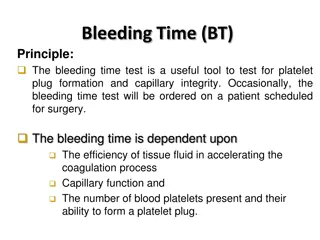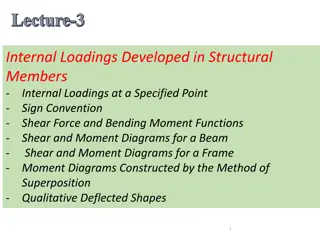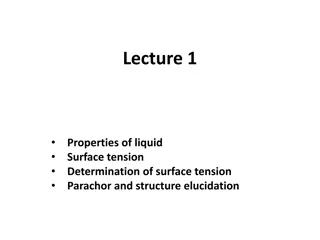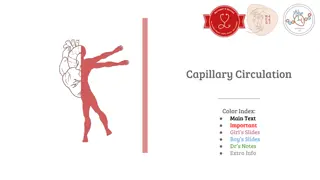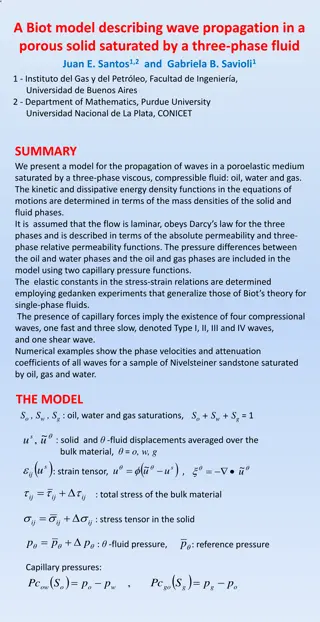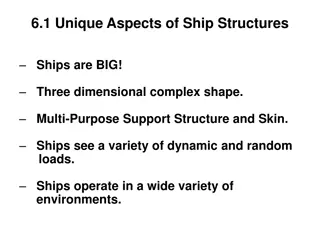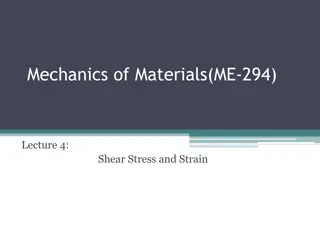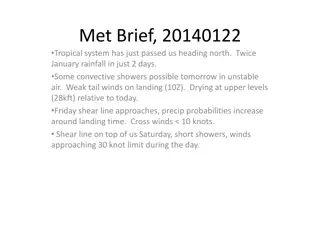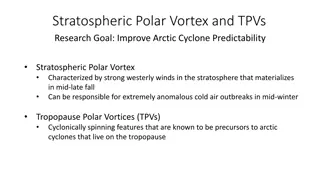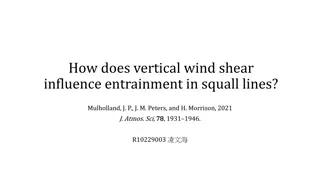Understanding Capillary Rheology: A Guide to High-Shear Behavior
Capillary rheology is a study of materials that flow, combining properties of liquids and solids. By passing liquids through small tubes, capillary rheology allows for the analysis of high-shear behavior, crucial for processes like extrusion and coating. Learn about the basic terms, anatomy of a capillary rheometer, and the inputs involved in this insightful field.
Download Presentation

Please find below an Image/Link to download the presentation.
The content on the website is provided AS IS for your information and personal use only. It may not be sold, licensed, or shared on other websites without obtaining consent from the author. Download presentation by click this link. If you encounter any issues during the download, it is possible that the publisher has removed the file from their server.
E N D
Presentation Transcript
Capillary Rheology Discovering the High-Shear Behavior of Materials Thomas Martindale Associated Polymer Labs
What is Capillary Rheology? Rheology is the study of materials that flow (Rhea = Flow ), which characterizes them both by properties of liquids (viscosity) and those of solids (elasticity). A capillary is a small tube, whose inner diameter is small enough that surface effects become significant forces acting on fluids that pass through the tube. Capillary Rheology is the process of studying viscous (flow- resistant) liquids by passing them through a small tube. Using a capillary allows for very high shear rates to develop in the liquids tested, which mimics important processes that occur at high shear rates (e.g. extrusion, high-speed coating).
Basic Terms of Capillary Rheology Capillary Rheometer: A device which measures the viscosity of liquids by measuring the force required to pass them through a capillary. This force F is equal to the resistance the fluid exerts against flowing through the capillary (Newton s Third Law). The rheometer consists of four basic parts: a barrel, a plunger, a die, and a means by which to apply and record force. The barrel is a cylindrical reservoir of the sample fluid. It is open on one end to permit the plunger to enter, and closed on the other end by the die. The plunger applies force. It is a solid metal rod fitted to the inner diameter of the barrel. It is connected to the crosshead, which applies force by means of a drive motor. The die is the capillary through which the test fluid must flow under load. It is a plug fitted to the opposite end of the barrel from the plunger entrance. It has a smaller aperture than the barrel.
Anatomy of a Capillary Rheometer Note that the barrel is much longer than the die, and that the die is no less than 10mm long itself. Some rheometers use transducers attached to the plunger, while others use a pressure sensor in the barrel. Piston = plunger, die = capillary.
Inputs to the Terms All terms used in capillary rheology derive from the rate Q at which the fluid flows through the capillary (die), The force of resistance F, that the sample fluid exerts on the plunger as fluid is forced through the capillary (die), -and- The dimensions of the barrel and capillary (die): rbarrel (the radius of the barrel), rcapillary(the radius of the hole in the die), and the length of the hole in the die, Lcapillary.
Basic Terms: Crosshead Speed Crosshead Speed, vcrosshead, is the rate at which the plunger is inserted into the barrel. It has units of meters per second for calculations, but millimeters per minute are the standard units entered into the rheometer.
Basic Terms: Volume Flow Rate Volume Flow Rate, Q, is the actual volume of sample fluid that flows through the capillary in a given amount of time, t. It has units of cubic meters per second, and is equal to the area of the barrel times the crosshead speed.
Basic Terms: Shear Rate The Shear Rate, , is the rate of shear strain, or the velocity gradient, in the sample fluid as it passes through the rheometer. This term describes how quickly the fluid is deformed as it flows from the large barrel to the small capillary (with respect to time) . Deformation is a change in shape: the fluid changes shape from a large-diameter cylinder ( coin-shaped ) in the barrel to a small- diameter cylinder ( pencil-shaped ) in the capillary. Note that this deformation is accompanied by a sudden jump in flow velocity (m/s) as the fluid enters the capillary, even though the Flow Rate Q (m3/s) remains the same.
Calculating Shear Rate Shear rate is calculated from flow rate and the size of the barrel & die by the equation on the left. On the right, that equation is expanded into its basic terms. The physical meaning of this equation is that as a larger volume of liquid flows from a large barrel to a small capillary in a given amount of time (i.e. as Q gets larger) , it changes shape quicker with respect to time. Also, the bigger the barrel is relative to the capillary, the higher the shear rate will be for the same flow rate Q.
This diagram shows the regions where flow does & doesn t occur. The stagnant/ vortex region doesn t flow- it stays in the barrel until the very end of the test. The area bordered by the stagnant region is where the shearing occurs: the wide coin-shaped volume of fluid transforms into the thin cylinder shape of the capillary. During the shear flow the speed of the fluid increases, volume stays the same, and pressure drops within the fluid (Venturi & Bernoulli effects) Particles suspended in the fluid will orient themselves parallel to the flow. This includes the polymer chains, microscopic mineral filler crystals, and even large glass fibers. This means that Capillary viscosity Brookfield viscosity! It will (almost) always be less!
Basic Terms: Shear Stress Shear Stress, , is magnitude of force per unit area, like any form of engineering stress. It specifically describes the stress resulting from the fluid deforming (shearing) as it enters and flows through the capillary. It is calculated from the force of resistance F, that the sample fluid exerts on the plunger as fluid is forced through the die, by the following formula:
Basic Terms: Viscosity Viscosity, , is the resistance of a fluid to flow and deformation. It can be thought of as the rheological equivalent of friction, which opposes motion at a surface. However, viscosity opposes motion within the mass of a semi-solid or fluid. Viscosity has units of Pascal-seconds (Pa s), or Shear Stress Time. However, the centipoise (cP) is the standard unit used to describe viscosity. One centipoise is equal to 0.001Pa s. Water 1-10cP, Corn Syrup 500cP, Honey 2,000 cP, polymer melts 100,000(+) cP
Viscosity vs. Shear Rate In all Non-Newtonian liquids, which includes all polymer solutions and melts, viscosity varies with shear rate. Shake, shake, shake, shake the ketchup bottle. First out comes a little and then an awful lottle! (Bingham Plastic behavior in which viscosity suddenly drops with at a specific shear stress = yield). Cornstarch & Water dilatent/shear-thickening (viscosity increases with increasing shear rate). Most hot-melt adhesives, polymer solutions: shear- thinning (viscosity drops with increasing shear rate) You will almost never test a Newtonian fluid.
Non-Newtonian Liquids Note: These charts plot stress over shear rate, and thus describe change in viscosity with respect to time at one applied force level. The curves are more pronounced when viscosity is plotted over shear rate using multiple force levels.
Viscosity vs. Shear Rate: Why do we care? By obtaining viscosity values at different shear rates, we can construct a mathematical model of how the fluid resists flow at different shear rates. The model is a mathematical equation, determined by a regression of a plot of points (X-axis = shear rate, Y-axis = viscosity) The model can predict fluid behavior in different processes, including drying paint ( levelling & sedimentation ), mixing fluid by hand, and high-speed coating (spin-coating, etc.). This is our goal. Plug in an expected shear rate (like in your extruder) into the model equation, and it will predict what viscosity the fluid will be during that process. Match materials (glue, solvent, plastic) to the process Match processing parameters (RPMs, C, slot die size) to the material Troubleshoot problems Test at different temperatures!
Calculating Viscosity Viscosity is Shear Stress divided by Shear Rate. Viscosity is calculated directly from the force of resistance F, that the sample fluid exerts on the plunger as fluid is forced through the die. We do this because force is what we can measure with our instruments. The viscosity is related to the force readings, F, by the length of the capillary, Lcapillary[m], the radius of the capillary, the radius of the barrel, Rbarrel[m] , and the Volume Flow Rate, Q [m3/s].
ASTM D3835, Your Rheometer, and You The formulae shared in blue are derived from the formulae provided in ASTM D3835, the Standard Test Method for Determination of Properties of Polymeric Materials by Means of a Capillary Rheometer. Those use Pressure readings, not Force. The equations are programmed directly into some rheometers, while the Associated Polymer Labs process applies them as an instrument method for a Universal Tester which measures force and crosshead speed. Other rheometers read out force without any calculations! Purpose-built rheometers keep these equations, and/or parameters like vcrosshead, rcapillary, rbarrel, and Lcapillaryinternally Pay no attention to the man behind the curtain! How can we use an instrument with proprietary dies, that only reports force? We learn about the instrument, then tailor our lab practice to use it.
Bringing an Old Rheometer to Life Because a purpose-built rheometer is designed as an instrument where fluid goes in, settings are entered, and force readings come out, using it takes some work but we know almost everything we need to use it! Revealing What s behind the curtain is a matter of a few steps. 1. Decide what shear rate(s) you need to simulate your process 2. Learn your instrument parameters 3. Design experiments 4. Set up data processing
Decide what you need from your rheometer Different sample fluids require different dies, and different temperatures Polymer melts Solutions Estimate the range of viscosities you ll need to test. Estimate the range of shear rates you ll need to test.
Learn your Instrument Parameters Inventory your dies, measure & label their dimensions on their containers Determine rbarrelso you can set up your calculations Find out the maximum force capacity of the sensor Find out the maximum vcrossheadof the instrument so you can choose the right die. Too big of a die opening may need too high a vcrossheadto hit your shear rates Too small of a die/too high of a viscosity will overload your force sensor
Set up an Instrument Method This is easiest to do in a spreadsheet. Choose your shear rates. Extrusion is between 2000- 6000 sec-1. Plug your barrel + die dimensions into Equation 1 to find out how fast your vcrossheadwill need to be for the shear rate you want. Make sure it s possible to run the test, and switch dies if it s not! Each test will use a different vcrosshead, and you will need to run one test at each shear rate you need. Equation
Bad Data: Sticking / Chattering plunger is not moving smoothly.
Bad Data: Air Bubble Notice the slow increase of force in the beginning + drop in force when the bubble extrudes through at 61mm: This is because air is compressible & has low viscosity (<1cP)
Setup of a typical test sheet Shear Rate (sec-1) Flow Rate Q (m3/s) Vcrosshead (m/s) Force Reading Viscosity (Pa s) F (N) 2000 = Equation 2 (2000s-1) = (Equation 3 (Q2000)) = (Equation 3 (Q3000)) = (Equation 3 (Q4000)) = (Equation 3 (Q5000)) = (Equation 3 (Q6000)) [directly from chart] = Equation 4 (Q2000, F2000) = Equation 4 (Q3000, F3000) = Equation 4 (Q4000, F4000) = Equation 4 (Q5000, F5000) = Equation 4 (Q6000, F6000) 3000 = Equation 2 (3000s-1) [directly from chart] 4000 = Equation 2 (4000s-1) [directly from chart] 5000 = Equation 2 (5000s-1) [directly from chart] 6000 = Equation 2 (6000s-1) [directly from chart] Equation Equation Equation
How to Use the Test Sheet Calculate vcrossheadshear rate before preparing samples. Input this value to the rheometer for the test trial being run. Load the samples into the rheometer, carefully avoiding air bubbles or solids that would clog the capillary. Test according to the manufacturer s instructions. If testing at elevated temperatures, allow the sample 3-5 minutes to equilibrate to the test environment. Make sure the plunger is in the barrel and also warms up in this time. Test the sample fluid at each vcrossheadshear ratelevel from the Test Sheet. Choose an appropriate force value F to input back into the Test Sheet, and the program will calculate the viscosity for that shear rate.
Set up your Data Processing Using a spreadsheet, plot viscosity over shear rate in a scatter plot. Use the Trendline feature to regress the data points into whatever function (power, exponential, etc.) best matches these points (has the highest R2statistic). This equation is the mathematical model used to predict the behavior of this specific material, at the test temperature, at any shear rate between the minimum and maximum shear rates tested. Report testing conditions and equipment dimensions along with the data and the equation.
The Future of Rheometers At APL, we seek to create user-friendly instruments and methods that will allow us to efficiently and accurately determine material properties, saving our customers time and money. There is a need for more efficient equipment and flexible methods in the field of capillary rheology. We are continuing to develop these methods and tools. Partnerships are appreciated!
Thank You for Your Time! Questions? Or, contact us at tom@plasticslab.com & jimz@plasticslab.com



